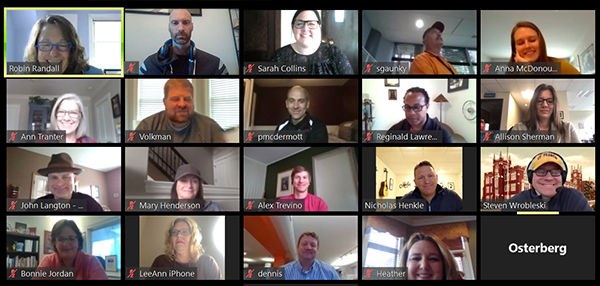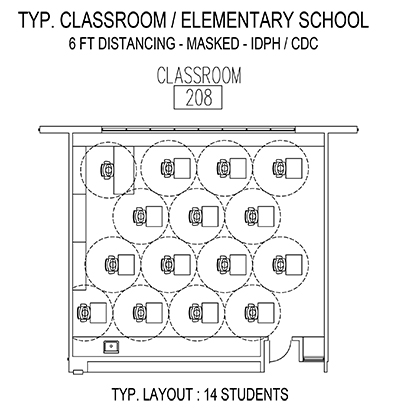
A tough road ahead as educators confront uncertainty, socioeconomic differences, scheduling concerns, and facilities obstacles amid COVID-19 pandemic
It’s the first day of school! Friends reunite and hug or high-five. Kindergartners hold hands in a circle. Students sit side by side in gyms, auditoriums, or cafeterias to listen to their principals. Right? Not so fast. The COVID-19 pandemic has changed the game.
Though districts are uncertain as to how the return to school will look in fall of 2020, one thing is certain: it won’t be the same.
The COVID-19 pandemic and resulting school closures have put tremendous pressure on school district leadership. The spotlight is on them to help community members balance family and job expectations. Administrators have been forced to make changes and to do so quickly. “We’re having to implement new procedures we’ve never had to deal with,” said Heather Rose, chief school business official at Forest Ridge School District 142.
And despite a lack of clear direction from state leaders, districts are considering many questions: How will they prepare for social distancing rules and keep schools disease-free? What role will remote learning play and how will socioeconomic differences between families complicate the matter? Will property tax extensions reduce district cash flow? How to continue supplying food for at-risk students?
At our recent online EDEngage 2.0 session, a dozen school district leaders from Illinois and Ohio shared the coronavirus-related challenges they’ve encountered in recent weeks, as well as their thoughts on how COVID-19 will impact the educational landscape in the coming months, especially when school resumes in fall.
The participants, representing both the academic and operations side of things, ranged from facilities and capital improvements directors to superintendents and business officials. The panel even included Bonnie Jordan, chief administrator of Philip J. Rock Center and School—the only publicly funded deaf-blind education center in the country.


Blended Schedules a Start
The American Federation of Teachers Association just released a “Plan to Safely Reopen America’s Schools and Communities.” It offers “five core pillars based on the science as well as educator and healthcare expertise—not on politics or wishful thinking.”
However, the EDEngage participants, craving more direction from state legislators, have many concerns about what the fall will look like.
When school resumes, one potential way of maintaining social distancing is a “blended” schedule that combines on-site and remote learning. Examples include a.m./p.m. schedules or splitting students into different days (e.g., school Monday and Tuesday for half the students, deep cleaning on Wednesday, school Thursday and Friday for the other half of students, deep cleaning on weekends).
This strategy does not, however, address issues with working parents and it creates many complications with transportation. Moreover, for some districts, blended scheduling simply would not be a feasible option for keeping six feet between students.
Channahon School District 17 Superintendent Dr. Nicholas Henkle pointed out the importance of districts keeping in touch with others in the region regarding when and how school will resume. “If the district next door opens and your district doesn’t,” he said, “there will be a firestorm on Facebook. We’re going to have to be flexible and do this one day at a time.”
The Good and Bad of Remote Learning
Dr. Reginald Lawrence, superintendent of Rock Island-Milan School District 41, suggested that even if schools open in the fall, many families will not be willing to send their children back and some teachers will be reluctant to return. Therefore, he encourages districts to further refine their remote learning capabilities and maximize certifications for teaching online.
Participants also noted inconsistencies in how each teacher delivers remote learning. LaSalle-Peru High School District 120 Superintendent Dr. Steven Wrobleski suggests that districts develop a “standardized remote learning framework across the curriculum” to combat this problem.

Conducting a successful online learning program also means ensuring that all families have access. Columbus City Schools Director of Capital Improvements Alex Trevino said that his 109-school district has delivered more than 10,000 Chromebooks and authorized purchase of 1,000 WiFi hot spots for families that lack access.
John Langton, superintendent of Addison School District 4, added that students who live in more affluent communities are more likely to be engaged in remote learning. In more financially challenged communities, internet access may be an issue or parents may not be in a position to help their children.
Presenting new learning concepts will be a challenge: remote learning was designed for repetition and reinforcement of previously learned concepts, but long-term retention of new materials presents a challenge. Remote learning for special education students adds another layer of complexity.
“Kids with internet access and parents who help will do okay,” said Langton, “but for kids without those resources, it’s going to be rough next fall.”
Roselle School District 12 Superintendent Dr. Mary Henderson echoed Langton, stating that when children of two-income families are left in charge, the remote learning progress of younger siblings suffers.
No matter how far a district has progressed with its distance learning capabilities, students will still miss out on critical benefits that come with face-to-face peer interaction. LeeAnn Taylor, chief school business official at Hawthorn School District 73, said, “Even if infrastructure in place, how do you balance social-emotional learning needs?”

Keeping Schools Virus-free
When students do return to school, how can administrators ensure that buses and facilities are as clean as possible? This is one of many questions that Allison Sherman, the newly appointed superintendent at Oak Grove School District 68, has been considering. Sherman, who has to touch three doorknobs to get from her office into the school, is considering hands-free alternatives like door pedals.
LeeAnn Taylor wonders how the sharing of materials and devices, particularly among younger students, will be impacted.
Another area where germs proliferate is the restroom. Schools might want to explore how to modify restrooms so that students will be able to enter the space, then wash and dry their hands without touching any surfaces.
Scott Gaunky, director of facilities at Lincolnshire-Prairie View School District 103, cautions districts about the importance of considering facilities from an environmental perspective, particularly when it comes to indoor air quality. Even if spaces are sanitized on a nightly basis, says Gaunky, the protection is at risk as soon as someone walks into the school.
Two weeks before the decision to close buildings, Gaunky and his team sprayed a product called SurfaceGuard 90 on every one of his district’s touchable surfaces, from keyboards and electronic devices to handrails and buses. The EPA-registered protectant forms a micro-biostatic antimicrobial coating that protects surfaces for up to 90 days.
More State Guidance
According to session participants, state response to the coronavirus pandemic has been less than satisfactory. For instance, one Illinois educational organization has attempted to meet with superintendents, then take their feedback back to the state level. “It has not been effective,” said one participant. “The concerns expressed have not been listened to.” Furthermore, when states wait until late on a Friday afternoon to announce a decision that impacts schools, districts are then forced to scramble all weekend long to alert families.
“We need more guidance from the state,” said Dr. Paul McDermott, superintendent of Forest Ridge School District 142. “We have to put kids back into schools for the mental welfare of parents trying to balance working and educating.”
Despite this lack of answers, districts continue to explore different contingencies for the return to school. Allison Sherman, for instance, is looking at three possible scenarios with cost projections for each.

District Communication Paves the Way
Allison Sherman started as associate superintendent at Oak Grove School District 68 three weeks before the shutdown. Regardless of the challenges she has confronted, Sherman keeps a positive attitude as she approaches her transfer to superintendent on July 1.
“Where there’s a lot of chaos and uncharted territory, there’s a lot of open hands,” said Sherman. “No new ideas or networking opportunities are turned away.”
Those who attended the EDEngage 2.0 meeting agreed that one of the most effective means of preparing for fall is keeping open the lines of communication between districts. It is with an appreciation for ongoing communication that we say “thank you” to all those who participated in the session:
- Scott Gaunky, Director of Facilities (Lincolnshire-Prairie View School District 103)
- Dr. Mary Henderson, Superintendent (Roselle School District 12)
- Dr. Nicholas Henkle, Superintendent (Channahon School District 17)
- Bonnie Jordan, Chief Administrator (Philip J. Rock Center and School)
- John Langton, Superintendent (Addison School District 4)
- Dr. Reginald Lawrence, Superintendent (Rock Island-Milan School District 41)
- Dr. Paul McDermott, Superintendent (Forest Ridge School District 142)
- Heather Rose, Chief School Business Official (Forest Ridge School District 142)
- Allison Sherman, Superintendent (Oak Grove School District 68)
- LeeAnn Taylor, Chief School Business Official (Hawthorn School District 73)
- Alex Trevino, Director of Capital Improvements (Columbus City Schools)
- Dr. Steven Wrobleski, Superintendent (LaSalle-Peru Township High School District 120)
And how are these individuals controlling stress? Taking walks, leaning on faith/spirituality, running, enjoying nature and the outdoors, and hitting the golf course.
A Call to District Leaders: Join the Conversation
If you are a school district leader, consider joining one of our forthcoming EDEngage sessions:
- EDEngage 2.7 on May 21, 10:00 a.m. CST will focus on facilities (e.g., sharing practical strategies for air quality, ventilation, cleaning, personal protective equipment, furniture layouts, etc.).
- EDEngage 3.0 on May 28, 10:00 a.m. CST will be an international Q & A for school leaders. We plan to have representatives from Australia, China, Germany, South Korea, and Sweden discussing school reopening.
If you would like to participate, please contact me.
Read a summary of our first EDEngage session during which superintendents from three states discussed COVID-19.
Contact us or comment below to share your thoughts on this post.


